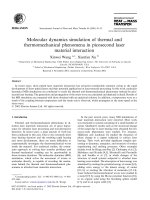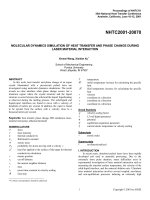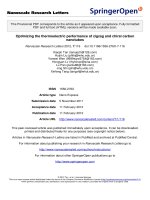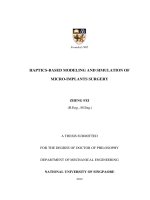Modeling and simulation of buckling of pristine and defective carbon nanotubes
Bạn đang xem bản rút gọn của tài liệu. Xem và tải ngay bản đầy đủ của tài liệu tại đây (6.45 MB, 198 trang )
i
MODELING AND SIMULATION OF BUCKLING OF
PRISTINE AND DEFECTIVE CARBON NANOTUBES
D. D. THANUJA KRISHANTHI KULATHUNGA
(B.Eng.(Hons.), University of Moratuwa, Sri Lanka)
A THESIS SUBMITTED
FOR THE DEGREE OF DOCTOR OF PHILOSOPHY
DEPARTMENT OF CIVIL ENGINEERING
NATIONAL UNIVERSITY OF SINGAPORE
2011
i
ACKNOWLEDGEMENTS
I would like to take this opportunity to acknowledge the guidance and
support of many people without those this thesis would have not been possible.
I owe my deepest gratitude to my supervisor, Associate Professor Ang Kok
Keng, for his invaluable guidance, encouragement and dedicated support which
helped me immensely in the completion of this research work.
It is an honor for me to be guided by my co-supervisor, Professor J. N.
Reddy, Department of Mechanical Engineering, Texas A&M University, USA. I’m
grateful to him for his constructive suggestions.
I appreciate the financial support and the facilities provided by National
University of Singapore to carry out this research.
It’s a pleasure to thank my colleagues, Ms Rupika Swarnamala, Ms Wang
Shasha, Dr Anastasia Maria Santoso, Ms Zhang Sufen, Dr Sai Sudha Ramesh, Dr
Liu Xuemei, Dr Nguyen Dat, Dr. Lado R. Chandra and Dr Patria Kusumaningrum
for their kind and encouraging words.
Last but not least I would like to thank my parents, brothers, sister and my
husband for being the best support to hurdle all the obstacles throughout this
research work.
ii
TABLE OF CONTENTS
ACKNOWLEDGEMENT i
TABLE OF CONTENTS ii
SUMMARY vi
LIST OF FIGURES ix
LIST OF TABLES xi
NOMENCLATURE xii
CHAPTER 1: INTRODUCTION 1
1.1 Background 1
1.1.1 Types of CNTs 1
1.1.2 Mechanical properties of carbon nanotubes 4
1.1.3 Applications of carbon nanotubes 5
1.2 Motivation 7
1.3 Objective and scope of work 11
1.4 Layout of the thesis 13
CHAPTER 2: LITERATURE REVIEW 15
2.1 Buckling of CNTs 15
2.1.1 Factors affecting buckling 16
2.1.2 Techniques employed in the buckling analysis 24
2.2 Defects in CNTs 30
2.2.1 Vacancy defects 30
2.2.2 Stone-Wales defect (SW defect) 33
2.2.3 Rehybridization defect (sp3 interwall bridging) 34
iii
CHAPTER 3: MOLECULAR DYNAMICS SIMULATIONS 37
3.1 Introduction to molecular dynamics simulations 37
3.1.1 Basic steps in MDS 37
3.1.2 Force fields 40
3.1.3 Ensembles 42
3.2 Simulation procedure for CNT under axial compression 43
3.3 Proposed simulation model 46
3.3.1 COMPASS force field 47
3.3.2 Simulation parameters 49
CHAPTER 4: AN IMPROVED SHELL MODEL FOR PRISTINE CNTS 55
4.1 Background 55
4.2 Introduction to shell theories 57
4.3 Governing equations 61
4.4 Analytical solution for buckling strain of SWNTs 69
4.4.1 Sanders shell theory solution 69
4.4.2 First-order shell theory solution 71
4.5 Analytical solution for buckling strain of DWNTs 73
4.5.1 Van der Waals interaction 73
4.5.2 Sanders shell theory solution 75
4.5.3 First-order shell theory solution 78
4.6 Results and discussion 80
4.6.1 Critical buckling strain of SWNTs 81
4.6.2 Critical buckling strains of DWNTs 86
4.7 Concluding remarks 89
iv
CHAPTER 5: BUCKLING OF EMBEDDED CNTS 92
5.1 Background 92
5.2 Simulation model 95
5.2.1 Matrix 96
5.2.2 Boundary condition 98
5.2.3 Volume fraction 100
5.3 Simulation procedure 102
5.3.1 Packing 103
5.3.2 Equilibration 104
5.3.3 Application of boundary condition 105
5.3.4 MDS parameters 107
5.4 Continuum mechanics modeling of embedded CNTs 108
5.5 Results and discussion 110
5.5.1 Convergence study 112
5.5.2 Choice of boundary condition 113
5.5.3 Effect of volume fraction 116
5.5.4 Buckling of embedded CNTs of various diameters 121
5.5.5 Buckling of embedded CNTs of various lengths 125
5.6 Concluding remarks 129
CHAPTER 6: BUCKLING OF DEFECTIVE CNTS 133
6.1 Background 133
6.2 Atomic simulation model 135
6.3 Results and discussion 135
6.3.1 Effect of vacancy defects on buckling properties of SWNTs 135
6.3.2 Effect of vacancy defects on buckling of DWNTs 149
v
6.3.3 Effect of vacancy defects on buckled shape of CNTs 151
6.4 Concluding remarks 154
CHAPTER 7: CONCLUSIONS AND RECOMMENDATIONS 156
7.1 Conclusions 156
7.2 Recommendations for future work 163
REFERENCES 166
LIST OF PUBLICATIONS 182
vi
SUMMARY
Carbon nanotube (CNT) is one of several nanomaterials that has attracted
enormous attention of researchers within the last two decades. Among the research
focuses of CNTs, the buckling behavior of CNT has taken an important place in
view that buckling is a major mode of structural instability of CNTs owing to their
hollow tubular nature and high aspect ratio. Despite the high number of studies
conducted on the buckling of CNTs, there are still several issues that are not
addressed sufficiently in the literature. For example, there appear to be little work
carried out in investigating the buckling of embedded CNTs and defective CNTs.
Moreover, there exist discrepancies between the results obtained from various
modeling techniques and these discrepancies have not been subjected to sufficient
discussion. The objective of this thesis is therefore to investigate the buckling of
freestanding pristine and defective CNTs as well as embedded pristine CNTs.
Molecular dynamics simulation (MDS) technique is employed as the main modeling
tool while analytical method based on continuum mechanics is also employed
wherever possible.
The scope of work carried out in this study can be divided mainly into three
parts. In the first part of the study, improved analytical formulae are proposed for the
buckling strain of single and double-walled carbon nanotubes based on Sanders and
first-order shell theories. It is noticed that the buckling strain values computed from
existing formula in the literature based on the Donnell shell theory do not show
sensitivity to aspect ratio (length/diameter ratio) of CNT. The lack of sensitivity is
vii
contrary to the results obtained from MDS where buckling strains actually show
considerable sensitivity to the aspect ratio of CNT. In the derivation of this widely
employed formula, certain terms have been omitted assuming that the shell buckles
into a large number of longitudinal waves. However, MDS results suggest this
assumption is not reasonable for the buckling of CNT. To avoid this erroneous
result, no such simplification was made in the derivation of the analytical formulae
proposed in this study. In addition, the proposed formula based on the first-order
shell theory accounts for the effect of transverse shear deformation, which could be
high in CNTs with small diameter and low aspect ratios. As a result, the proposed
formulae appear to generate results with improved accuracy compared to the widely
employed formula existing in the literature.
The second part of the thesis is focused on the buckling of embedded CNTs.
MDS based studies on buckling of embedded CNTs are found to be lacking in the
literature. As a result, the accuracy of the continuum mechanics models employed in
analyzing buckling of embedded CNTs is not sufficiently verified. Buckling of
fibers has been identified as a major mode of failure of composites in general. This
scenario has been observed in CNT based composites as well. It would therefore be
important to investigate the buckling properties of embedded CNTs. Detailed
molecular dynamics study is thus carried out in this thesis to investigate the buckling
of pristine embedded CNTs. In addition, the accuracy of the continuum mechanics
based analytical models in predicting buckling properties of embedded CNTs is
discussed. The analytical models employed in this study are well-known equations
for beam or shell on an elastic foundation in which the elastic foundation is modeled
as a Winkler foundation. In addition to these well-known formulae, the first-order
shell theory based formula proposed in the first part of the study combined with the
viii
Winkler model is also proposed to predict the buckling properties of embedded
CNTs. Of the three formulae considered in this study, the proposed formula is
found to produce the most accurate results irrespective of the buckling mode.
However, even the results obtained from the proposed formula appear to deviate
considerably from the results obtained from molecular dynamics simulations.
It appears from a review of the literature that the buckling of defective CNTs
is also not sufficiently examined. Despite the use of very high quality techniques in
the production of CNTs, it has been reported that CNTs are still being produced with
defects. Defects are found to create significant effect on tensile properties of CNTs.
Hence, it is important to know the effect of defects on the buckling properties of
CNTs. The third part of this thesis presents the investigation on the buckling
properties of defective freestanding SWNTs and DWNTs using MDS. Several types
of defects have been identified in CNTs. Among them, non-reconstructed vacancy
defects are the type of defects that cause the highest degradation of buckling
properties. Therefore in this study, various configurations of non-reconstructed
vacancy defects are investigated to identify the severity of degradation of buckling
properties expected in defective CNTs. The effect of defects on buckling properties
under various thermal environments is also examined.
ix
LIST OF FIGURES
Figure 1.1: Graphical representation of chirality of CNTs 3
Figure 1.2: CNT brushes 7
Figure 2.1: Slits and holes resulting from large number of missing atoms 31
Figure 2.2: Various configurations of vacancy defects 32
Figure 2.3: Formation of SW defect through 90
0
bond rotation 34
Figure 2.4: Typical defects in SWNT 35
Figure 2.5: Rehybridization defect in DWNT 36
Figure 3.1: Graphical representation of bond energies 40
Figure 3.2: Force-displacement curves of CNT 45
Figure 3.3: Critical buckling strains obtained using different thermostats and
displacement steps 51
Figure 3.4: Convergence study on duration of simulation 54
Figure 4.1: Deformation of a transverse normal according to various shell theories 60
Figure 4.2: Sign convention 61
Figure 4.3: Critical buckling strain versus aspect ratio for SWNTs 82
Figure 4.4: Critical buckling strain of SWNTs with varying diameters 85
Figure 4.5: Buckled shapes of (7, 7) SWNT 86
Figure 4.6: Critical buckling strain of DWNT (4, 4) (9, 9) 88
Figure 4.7: Critical buckling strain of DWNTs at aspect ratio 6 89
Figure 5.1: Simulation model 96
Figure 5.2: Schematic representation of different polymer matrices 97
x
Figure 5.3: Schematic representation of periodic boundary condition 98
Figure 5.4: Slab boundary condition 99
Figure 5.5: Schematic representation of vdW separation distance 101
Figure 5.6: RDF for (5, 5) CNT of length 5 nm 102
Figure 5.7: Deformation of embedded CNT during equilibration 111
Figure 5.8: Convergence study 113
Figure 5.9: Variation of buckling stress with the increasing volume fraction 118
Figure 5.10: VdW energy at different volume fractions 119
Figure 5.11: Variation of number of matrix atoms per unit volume with volume
fraction 121
Figure 5.12: Buckling properties of CNTs with varying diameters 122
Figure 5.13: Buckled shapes of CNTs with varying diameters 123
Figure 5.14: Variation of buckling properties with varying lengths 126
Figure 5.15: Buckled shapes of (5, 5) CNTs with varying lengths 128
Figure 6.1: Various configurations of vacancy clusters 137
Figure 6.2: Force-displacement curves for pristine and defective (7, 7) CNTs 139
Figure 6.3: Force-displacement curves for symmetric and asymmetric vacancies 140
Figure 6.4: Force-displacement curves for pristine and defective CNTs 142
Figure 6.5: Load-displacement curves for one or two vacancy clusters 143
Figure 6.6: Dangling bonds in armchair and zigzag CNTs 146
Figure 6.7: Effect of temperature on pristine and defective CNTs 147
Figure 6.8: Buckling mode shapes of pristine and defective SWNTs 152
Figure 6.9: Buckling mode shapes for pristine and defective DWNT 153
xi
LIST OF TABLES
Table 3.1: Functional forms of energy components included in COMPASS force
field 48
Table 4.1: Strain-displacement relationships 62
Table 4.2: Stress resultants-strain relationships 63
Table 4.3: Error percentages correspond to the analytical formulae 84
Table 5.1: Buckling properties for embedded SWNT with periodic and non-periodic
boundary conditions 114
Table 5.2: Buckling properties of embedded SWNT with periodic and non-periodic
(fixed matrix) boundary conditions 116
Table 6.1: Percentage reduction of buckling properties due to vacancy defect 138
Table 6.2: Effect of chirality on buckling of defective CNTs 145
Table 6.3: Buckling properties of defective DWNTs 149
xii
NOMENCLATURE
m
i
, r
i
Mass and position vector of the i
th
atom
i
F
Force acting on i
th
atom
V Total potential energy of the system
m, n Half the number of longitudinal, circumferential waves
u, v, w Displacements of any point of shell in x, y and z directions
u
0
, v
0
, w
0
Displacements of a point in the middle plane of the shell in x,
y and z directions
,
x y
φ φ
Rotations of a transverse normal about y
and
x
axes
, ,
x z
θ
Axial, circumferential and thickness directions
0 0 0 0 0
, , , and
x x z x
θ θ θ
ε ε ε ε ε
Membrane strains
1 1 1
, and
x x
θ θ
ε ε ε
Flexural strains
s
K
Shear correction factor
ˆ
N
Axial compressive load per unit circumferential length
R
i
Radius of the
i
th
wall
E
Young’s modulus
D
Bending stiffness
v
Poisson’s ratio
U
mn
, V
mn
, W
mn,
X
mn
,
Y
mn
Coefficients of the assumed displacement functions
xiii
h
Thickness of the shell
L
Length of CNT
c
i
Van derWaals coefficients of
i
th
wall
CNT
f
Volume fraction of CNT in a composite
h
vdw
Van der Waals separation distance between CNT and matrix
k
Winkler foundation modulus
E
m
Young’s modulus of matrix
0
K
modified Bessel function of the second kind
1
CHAPTER 1
1
INTRODUCTION
1.1 Background
1.1.1 Types of CNTs
Carbon nanotube which has remarkable mechanical, electrical and thermal
properties was first discovered by Sumio Iijima (1991). Carbon nanotube (CNT) is
basically a cylinder with a single layer of atoms where each carbon atom is bonded
to three other carbon atoms via covalent bonds. Therefore, CNT can be viewed as a
graphene sheet rolled up to the shape of a cylinder. Depending on the geometry of
CNT, the following categories of CNT can be found.
Single-walled and multi-walled carbon nanotubes
CNTs as single-walled carbon nanotubes (SWNTs) or multi-walled carbon
nanotubes (MWNTs). As the names imply, SWNT consists of a single CNT whereas
MWNT contains several CNTs inserted within one another with an inter-wall
spacing of approximately 0.34 nm (Kiang et al., 1998). Walls of MWNTs are
bonded by the weak van der Waals forces which are defined as attractive or
repulsive forces between atoms or molecules.
2
Zigzag, armchair and chiral carbon nanotubes
CNTs are also categorized as chiral or achiral carbon nanotubes. The latter
comprises of both zigzag and armchair carbon nanotubes. This categorization is
done based on the orientation of carbon-carbon (C-C) bonds. Orientation of C-C
bonds is characterized by the chiral vector,
1 2
h
C ma na
= +
where
1 2
and
a a
are the
base vectors of magnitude 1.42 A
0
and the integers
m
and
n
are the translation
indices (see Figure 1.1). Translation indices are also called chiral indices. The chiral
angle is defined as the angle
1
between and
h
C a
θ
and it varies from 0
0
to 30
0
.
Nanotubes having chiral angle of 0
0
and 30
0
are called zigzag and armchair,
respectively, while nanotubes having chiral angles between 0
0
and 30
0
are called
chiral CNTs. SWNTs are uniquely defined by the integer pair (
n,m
) or equivalently
the corresponding chiral angle. Zigzag and armchair CNTs are represented by the
integer pairs (
n, 0
) and (
n, n
) respectively, while chiral CNTs are represented by
(
n,m
). Chiral indices
n
and
m
take values greater than or equal to 3 except for zigzag
CNTs where
m
takes the value of zero. The diameter (in nm) and chiral angle of a
SWNT can be expressed in terms of chiral indices as shown in equations 1.1 and
1.2, respectively.
2 2
0.246
in nanometers
n m nm
d
π
+ +
=
(1.1)
1
2 2
3
sin
2
m
n m nm
θ
−
=
+ +
(1.2)
According to equation (1.1), the smallest CNT has a diameter of 0.234 nm.
3
Figure 1.1: Graphical representation of chirality of CNTs
Pristine and defective carbon nanotubes
It is now well known that CNTs are susceptible to defects (Ebbesen and
Takada, 1995, Yuwei et al., 2005). This leads to another categorization of CNTs as
either pristine or defective CNTs. Defects can occur in CNTs during production or
purification processes. Some defects are produced in an excessive temperature
environment or under higher stresses. Also, defects can be deliberately introduced
by chemical treatment or irradiation (exposing to radiation). For example, in
developing field-effect transistors, pentagon-heptagon defects are introduced
deliberately to join two CNTs with different chiralities through intramolecular
junctions. Defects produced through all these means can be categorized into three
main groups. They are topological defects, rehybridization defects and incomplete
bonding defects. Topological defects occur due to the presence of carbon rings other
Zigzag Chiral Armchair
θ
2
ma
1
na
1
a
2
a
h
C
0, 0
m
θ
= =
Zigzag
0,
m n
θ
= =
Armchair
4
than hexagons. Incomplete bonding defects refer to the vacancy defects which are
produced due to missing carbon atoms. Rehybridization defects are produced from
the presence of sp
3
bonds in CNT. Normally, CNTs consist of sp
2
carbon bonds
where each carbon atom is bonded to 3 other carbon atoms. Under certain
circumstances, sp
2
bonds can be turned into sp
3
bonds where each carbon atom is
bonded to 4 other carbon atoms.
1.1.2 Mechanical properties of carbon nanotubes
Carbon nanotube is known to possess superior mechanical properties. These
properties have spurred considerable interest amongst researchers and as a result
many experimental and theoretical studies have been performed so far to explore
these remarkable material properties. Most of the experimental based studies suggest
the longitudinal Young’s modulus of CNT to be about 1 TPa (Krishnan et al., 1998,
Wong et al., 1997, Dresselhaus et al., 2004, Hernandez et al., 1999). This value of
Young’s modulus is five times larger than the Young’s modulus of steel. However,
some theoretical studies suggested the Young’s modulus of CNT to be about 5 TPa.
For example, Yakobson et al (1996) suggested a value of 5.5 TPa for the Young’s
modulus of CNTs based on the bending stiffness value of CNTs. Here, they
considered the CNT thickness to be 0.066 nm. Similarly, Zhou et al (2000) also
obtained 5.1 TPa for the Young’s modulus and 0.074 nm for the thickness using
bending strain energy obtained from electronic energy band theory. In contrast,
Giannopoulos et al (2008), Jin and Yuan (2003) and Chunyu and Tsu-Wei (2003)
obtained Young’s modulus of about 1 TPa from their theoretical investigations.
However, in these studies the thickness of CNT is taken as 0.34 nm. Therefore, it is
clear that theoretically calculated Young’s modulus value depends on the value of
5
the thickness of CNT assumed. Unfortunately there appears to be no agreement in
the literature what the actual value of thickness should be which could not be
resolved since measurement of the thickness through experiments is not easy to
carry out.
In addition to the remarkable Young’s modulus, CNT is known to possess
over a hundred times higher tensile strength compared to that of steel. Although
various studies (Li et al., 2000, Yu et al., 2000a, Yu et al., 2000b, Demczyk et al.,
2002) suggested various values for the tensile strength of CNT, the mostly accepted
value is about 60 GPa.
1.1.3 Applications of carbon nanotubes
Due to the exceptional mechanical properties and the light weight, scientists
envisaged many potential applications of CNTs. Some of those potential
applications have now become real-world applications. The followings are some of
the real-world as well as potential applications of CNTs.
Carbon nanotube based probe tips
This is one of the real-world applications of CNTs up to date. CNT probes
have been shown to improve image resolution as well as durability of AFM (atomic
force microscope) tips compared to the conventional Silicon tips. This high
resolution provided by CNT probes enable AFM to produce better imaging of
surfaces as well as biological species such as DNA.
6
As reinforcing agents in nanocomposites
Due to the high stiffness, strength as well as high aspect ratio of CNTs
compared to the conventional carbon fibers, researchers predicted CNTs as a good
reinforcing agent in composites. Many studies have already been devoted to
investigate the applicability of CNT as reinforcing fibers in polymer, metal and
ceramic matrices (Qian et al., 2000, Zhan et al., 2003). These CNT composites are
expected to be useful in applications where high strength and light weight is
important such as sporting goods, body armors, automobiles and aircrafts.
Carbon nanotube sensors
Electrical properties of CNTs are highly sensitive to the atomic structure of
CNT. Owing to this characteristic, CNTs have been proposed for use as chemical or
mechanical sensors (Inpil et al., 2006, Sinha et al., 2006, Endo et al., 2008).
Carbon nanotube brushes
With the invention of methods to develop aligned CNT arrays, CNT brush
has also become a potential application of CNT. Anyuan et al (2005) proposed
aligned MWNTs as a feasible option for microscale brushes which can be used to
clean nanoparticles from narrow spaces or to coat inside holes. Also, Toth et al
(2009) suggested CNT to be used as brushes in electric motors due to the flexibility
and conductance of CNTs. Figure 1.2 shows two CNT brushes constructed by
Anyuan et al (2005). In these brushes, bristles are made of CNTs while the handles
are made of Silicon Carbide.
7
Figure 1.2: CNT brushes
Conductive plastics and films
Due to the higher aspect ratios and good electrical conductivity, CNTs have
found applications in conductive plastics. These conductive plastics are made by
filling plastics with nanotubes. In addition, carbon nanotubes are now tested to make
conductive films which can be used in LCD’s and touch screens.
1.2 Motivation
Understanding the mechanical properties and behavior of CNTs is crucial
towards identifying potential applications of CNTs. Furthermore, this knowledge is
essential in designing CNT based devices. Therefore, many researches are focused
on studying the mechanical behavior of CNT such as fracture, buckling and
vibration of CNTs. Owing to the hollow tubular nature, buckling has been identified
as a major mode of failure of CNTs. In addition to the degradation of mechanical
strength, buckling has been found to affect electrical and optical properties of CNTs
as well (Dekker, 1999, Shan and Bao, 2006). Therefore, buckling of CNTs has
become a topic of interests among researchers. Many studies have already been done
8
on the buckling of CNTs. However, there are still several areas which have not
gained sufficient attention.
One of such areas which have not been fully explored is to examine in depth
whether continuum mechanics models can be used to predict well the buckling
properties of CNTs. These continuum models consist of analytical as well as
numerical models. Analytical models have been extensively explored due to their
simplicity in application. Even though the accuracy of the analytical expressions of
some of the previous works has been verified for certain cases, it is noted that there
are also some discrepancies between the results of many of these analytical models
and the results obtained from MDS. One shortcoming of the analytical shell models
widely employed in the literature to calculate buckling strains of CNTs is the
insensitivity to the aspect ratio of the CNT (length to diameter ratio) which is
contrary to findings from MDS based studies which concluded that the buckling
strain is quite sensitive to aspect ratio of CNTs even within the shell buckling region
(Li and Chou, 2004, Liew et al., 2004, Sears and Batra, 2006, Wang et al., 2005,
Zhang et al., 2009a). It is also noticed that as a result of this shortcoming, there is a
significant error in the values calculated from existing shell models especially for
CNTs with smaller diameters. It is noted that the existing shell models used for the
buckling analysis of CNTs are based on simplified Donnell’s Shell theory. The
simplification in this shell theory is based on the assumption that cylindrical shells
buckles into a large number of longitudinal waves. However, in contrast to this
assumption, MDS based studies showed that CNTs displaying shell buckling
behavior generally buckle only into one or two waves (Cao and Chen, 2006a, Shen
and Zhang, 2006, Tan et al., 2007, Lu et al., 2008). Moreover, Donnell’s shell theory
neglects the transverse shear which could be significant in tubes with smaller
9
diameters. Therefore, it is likely that accounting for these two factors would improve
the accuracy of the existing shell models.
Another issue which has not gained sufficient attention is the buckling of
embedded CNTs. CNT has been identified as an excellent candidate as reinforcing
fibers in nanocomposite. Moreover, buckling of embedded CNTs has been observed
experimentally and identified as a major mode of failure of composites (Lourie et
al., 1998, Thostenson and Chou, 2004, Hadjiev et al., 2006). Hence, it is important
to know the buckling properties of CNTs embedded in matrices. Having identified
this importance, several studies have been devoted to the study of the buckling of
embedded CNTs (Ru, 2001, Kitipornchai et al., 2005, Liew et al., 2005, Yao and
Qiang, 2006, Yang and Wang, 2006, Zhang et al., 2006b). However, these studies
are based on continuum mechanics modeling. Moreover, these continuum mechanics
models are not sufficiently verified due to the absence of MDS studies. From a
review of existing literature, there appears to be only one study carried out on the
buckling of embedded CNTs which employs MDS (Namilae and Chandra, 2006). In
this study, the matrix considered is a crystalline polymer employing non-periodic
boundary conditions. Commercial polymers are combination of crystalline and
amorphous polymer and hence it is important to study the behavior of embedded
CNT in amorphous polymer as well. On the other hand, non-periodic boundary
conditions may not represent the bulk nature in a composite. Therefore, clearly there
exists a necessity for more MDS based studies to investigate the buckling of
embedded CNTs.
The next issue which has not been studied enough is the buckling of
defective CNTs. Various types of defect has been found unavoidably in CNTs
(Ebbesen and Takada, 1995, Charlier, 2002). Even with the use of high quality
10
production methods, it has been reported that there are defective CNTs still being
produced. Many studies have been focused on exploring the tensile properties and
fracture of defective CNTs (Belytschko et al., 2002, Chandra et al., 2004,
Sammalkorpi et al., 2004, Xiao and Hou, 2006, Wang et al., 2007c, Yuan et al.,
2007, Pozrikidis, 2009). These studies have discovered that defects do influence
significantly the tensile properties of CNTs. Comprehensive studies on the effect of
defects on the buckling of CNTs are however very much lacking in the literature.
Even the few studies reported in the literature show contradicting results. For
example, Xin et al (2007) observed a significant effect of defects on the buckling
properties of SWNTs while Wang et al (2008c) observed only a minor effect.
Several methods have been developed to identify the type of defects in CNTs
(Krasheninnikov and Nordlund, 2002, Hashimoto et al., 2004, Ishigami et al., 2004,
Miyamoto et al., 2004, Yuwei et al., 2005) and more research efforts are currently in
progress to develop advanced techniques in identifying the defects. Therefore, it is
possible to estimate the expected behaviour of a sample of CNTs under
compression, once the defect density and the degradation of properties due to defects
are known. This could also be used as a measure to decide whether CNTs produced
by a certain technique is good enough for certain application. Hence, exploring
degradation of buckling properties caused by various types of defects can also be
identified as an important research area.
11
1.3 Objective and scope of work
It is clear from section 1.2 that there exist several gaps in the literature
regarding understanding the buckling properties of CNTs despite the high number of
studies conducted so far. It is thus important to address these gaps through more
studies. The objective of this thesis is to investigate the buckling properties of
pristine/defective freestanding CNTs and pristine embedded CNTs. Molecular
dynamics simulation (MDS) technique will be employed as the primary tool for the
study supplemented with an analytical method based on continuum mechanics
modeling of the CNT wherever possible.
The scope of work carried out to achieve the objective of this study can be
grouped into three parts. In the first part of the study, improved analytical
expressions for the buckling strain of pristine CNTs are obtained. These expressions
are derived from well-established continuum mechanics principles using both
Sanders and First-order shell theories to model the buckling behavior of CNT. It
should be emphasized there that the Sanders shell theory solutions derived here are
more accurate than existing Donnell shell theory solutions as Sanders shell theory is
a more refined thin shell theory. First-order shell theory based solution accounts for
the transverse shear deformation. It is expected that these two factors contribute
towards improving the accuracy of the proposed analytical shell model expressions
for calculating the buckling strain and hence buckling stress of CNTs. Analytical
solutions are presented for the buckling of both SWNT and DWNTs. Finally, the
first part of the current study will present the results obtained from molecular
dynamics simulation (MDS) using COMPASS forcefield to simulate the interaction









